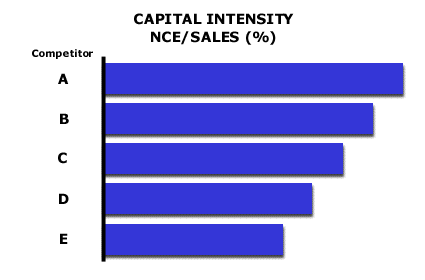Analysis 55: Capital Intensity
EXHIBITS:

| HOW TO INTERPRET THE ANALYSIS: This exhibit is shown without numbers. Capital Intensity is a ratio of capital or assets divided by sales. Competitor E is likely to have the lowest capital costs in the industry. This competitor has the lowest Net Capital Employed (NCE) as a percentage of sales in the industry. A company's total Net Caplital Employed equals the sum of all interest bearing debt plus all forms of equity. When Net Capital Employed is divided by the sales of the Company, the result is a measure of Capital Intensity. The lower the ratio of Net Capital Employed to Sales, the less capital is required in order to product a dollar of sales. Competitor A uses the most.
PURPOSE: This analysis enables the Company to evaluate its abilities in asset and free liability management. The company with the lowest Capital Intensity is likely to be doing the best job of managing the asset side of its business and probably has the industry's lowest Capital Cost. The Company uses this analysis to help set performance targets for Caplital Intensity in order to meet its Return on Investment goals. APPROACH: This analysis shows the result of dividing each company's Net Capital Employed (NCE), which is the sum of its interest bearing debt plus equity, by the total sales of the Company. In many cases, the Company will use business line statistics, which provide allocated operating assets for each competitor's business. Where the Company conducts the analysis on the basis of its own and competitors' business line data, this analysis is the result of the division of allocated assets by business line sales. If the company uses the Company uses the comparisons of Capital Intensity among competitors, it will be able to see how well each competitor manages free liabilities, such as accounts payable, taxes payable and various reserve accounts, as well as its overall assets. This analysis focuses on the asset and capital side of the return management task. Here the competitor with the lowest ratio of capital, or assets, to sales is the most efficient at using his capital in the industry. The Company would use this competitor to benchmark its capital and asset management performance. Return to Diagnose Costs: Measuring Current Shortfalls in Financial Performance |
|
Recommended Reading |
| For a greater overall perspective on this subject, we recommend the following related items:
Analyses: Videos: Symptoms and Implications: Symptoms developing in the market that would suggest the need for this analysis. Perspectives: Conclusions we have reached as a result of our long-term study and observations.
|
